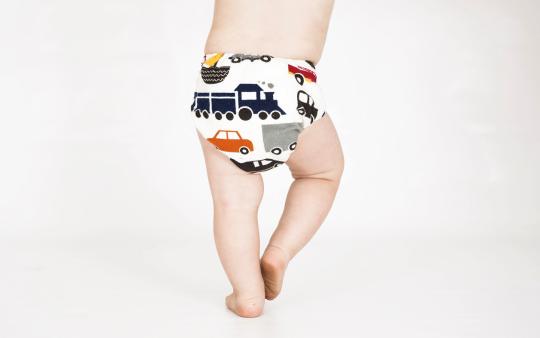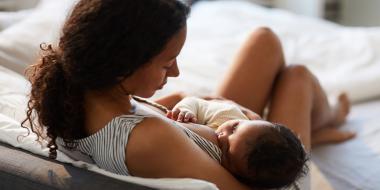It should only take a little bit of math to convince you to choose cloth diapers. Let’s make a very modest estimate of six diapers per day, for a modest two and a half years. (My son was in diapers until three and half, by the way!) That’s nearly 5500 diapers that will hit the landfill, unlikely to biodegrade much for at least half a millennium. You’re making a substantial difference even if you only choose cloth diapers half the time! But I know there are a lot of naysayers around you, probably telling you that cloth diapers are gross and you’ll never stick with them. I had my share of funny looks when I told people six years ago that I was going the cloth route. I get it. Cloth seems like a lot of work. The lingo seems like an impossible-to-crack code. It seems like you’ll have to touch a lot of poop. It seems like it will be really expensive. But I promise you won’t regret it!
How much work is it?
You can count on about three extra loads of laundry each week. I wash my children’s clothes with our cloth diapers (after they’ve gone through a rinse cycle by themselves), so I don’t find it to be much more laundry. Think of it like doubling the recipe when you're cooking!
Are cloth diapers gross?
If you’re not prepared to handle poop and pee, using disposables isn’t going to save you from parenthood! In some ways, I find using cloth to be less disgusting. Disposables smell terrible in the trashcan. (That’s why they make those products that individually seal each dirty diaper in plastic!) Since you are flushing the poop from your cloth diapers down the toilet, the nursery doesn’t smell like dirty diapers, and even cloth diapers filled with urine don’t stink the same way disposable diapers do. There are many products out there to help take the ick-factor out of cloth, from diaper sprayers and splatter shields to biodegradable liners.
Does it actually save money?
Yes! Even if you buy higher priced cloth diapers, you’ll still be spending less than if you purchase disposables for three years. When you think about cost, it’s also important to remember that you can use your cloth diapers on more than one child. I am using cloth diapers on my daughter that I also used on my son, and have resold some of our diapers that we don’t need. I don’t think I need to tell you that you can’t “hand down” a used disposable and you definitely can’t put it up on Craigslist. In terms of the cost of extra laundry, you’re looking at pennies per load.
You can equip yourself with everything you need to cloth diaper from newborn to potty-training for under $500. Compare that to the above number of disposables multiplied by cost per each and you get the picture. You're saving money!
Is it complicated to wash them?
No soaking required! You get as much of the solids into the toilet as possible, then store your diapers in a pail or wet bag until wash day. When you wash, you’ll run a quick, cold wash with detergent first. Then, add in some other laundry if you want and run a heavy, hot wash with enough detergent for a heavily soiled load. Diapers can be dried on low or hung to dry.
What’s with all this lingo?
If you start researching cloth diapers online, it’s easy to get turned off by the sheer volume of choice and the superfluous abbreviations. What you need to keep clearly in your mind is that a cloth diaper is, fundamentally, a very simple contraption. No matter what fancy name it bears, a complete cloth diaper has a waterproof exterior and an absorbent inner. The way in which these two parts are combined leads you to the three most common styles of diapers.
- All-in-Ones (AIOs) have a waterproof outer and absorbent inner that are sewn together in ONE piece.
- All-in-Twos (AI2s) have a waterproof outer (called a cover) that is separate from the absorbent inner. You put them together before use, and often reuse the cover for a couple of diaper changes.
- Pocket diapers are waterproof covers that have an inner pocket, and into that pocket you slide your absorbent portion (called an insert).
Cloth diaper trial kits are available both online and in-store from many retailers: for $100 or so, you can really get to know the different styles of diapers and decide what works for you. Shops typically then offer you credit towards purchasing your diapers at the end of your trial.
What do I need to get started?
Cloth diaper buying can seem daunting, but it doesn't need to be. I recommend a bare minimum of 24 diapers. The more diapers you have, the less frequently each diaper is washed over its lifetime, so the longer each one will last. You will also want to buy a few wet bags, used to transport dirty diapers when you’re out and about, and a pail or large wet bag to store all your dirty diapers between washings.
If you have a cloth diaper retailer local to you, check if they offer information sessions or trial kits. Consider joining online cloth diaper communities on Facebook, or search Pinterest and cloth diaper blogs for more specific help.






